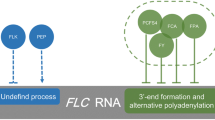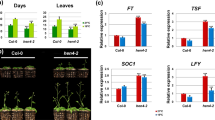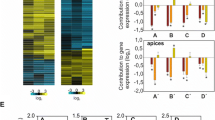Abstract
The timing of floral transition has significant consequences for reproductive success in plants. The molecular genetic dissection of flowering time control in Arabidopsis identified an integrated network of pathways that quantitatively control this developmental switch. A central player in this process is the FLOWERING LOCUS C gene (FLC), which blocks flowering by inhibiting the genes required to switch the meristem from vegetative to floral development. Three systems (the FRIGIDA gene, vernalization, and the autonomous pathway) all influence the state of FLC. Last years many new genes have been identified that regulate FLC expression, and most of them are involved in the modification of FLC chromatin. This review focuses on recent insights in FLC regulation.
Similar content being viewed by others
Abbreviations
- ChIP:
-
chromatin immunoprecipitation
- FLC :
-
FLOWERING LOCUS C
- FRI :
-
FRIGIDA
- LD:
-
long day
- NLS:
-
nuclear localization signal
- PHD:
-
plant homeodomain
- RRM:
-
RNA recognition motifs
- siRNA:
-
short interfering RNA
- WT:
-
wild type
References
Koornneef, M., Alonso-Blanco, C., Peeters, A.J., and Soppe, W., Genetic Control of Flowering Time in Arabidopsis, Annu. Rev. Plant Physiol. Plant Mol. Biol., 1998, vol. 49, pp. 345–370.
Simpson, G.G. and Dean, C., Arabidopsis, the Rosetta Stone of Flowering Time? Science, 2002, vol. 296, pp. 285–289.
Bäurle, I. and Dean, C., The Timing of Developmental Transitions in Plants, Cell, 2006, vol. 125, pp. 655–664.
Suárez-López, P., Wheatley, K., Robson, F., Onouchi, H., Valverde, F., and Coupland, G., CONSTANS Mediates between the Circadian Clock and the Control of Flowering in Arabidopsis, Nature, 2001, vol. 410, pp. 1116–1120.
Wilson, R.N., Heckman, J.W., and Somerville, C.R., Gibberellin Is Required for Flowering in Arabidopsis thaliana under Short Days, Plant Physiol., 1992, vol. 100, pp. 403–408.
Gómez-Mena, C., Pineiro, M., Franco-Zorrilla, J.M., Salinas, J., Coupland, G., and Martínez-Zapater, J.M., EARLY BOLTING IN SHORT DAYS: An Arabidopsis Mutation That Causes Early Flowering and Partially Suppresses the Floral Phenotype of Leafy, Plant Cell, 2001, vol. 13, pp. 1011–1024.
Sheldon, C.C., Finnegan, E.J., Rouse, D.T., Tadege, M., Bagnall, D.J., Helliwell, C.A., Peacock, W.J., and Dennis, E.S., The Control of Flowering by Vernalization, Curr. Opin. Plant Biol., 2000, vol. 3, pp. 418–422.
Michaels, S.D. and Amasino, R.M., FLOWERING LOCUS C Encodes a Novel MADS Domain Protein That Acts as a Repressor of Flowering, Plant Cell, 1999, vol. 11, pp. 949–956.
Sheldon, C.C., Burn, J.E., Perez, P.P., Metzger, J., Edwards, J.A., Peacock, W.J., and Dennis, E.S., The FLF MADS Box Gene: A Repressor of Flowering in Arabidopsis Regulated by Vernalization and Methylation, Plant Cell, 1999, vol. 11, pp. 445–458.
Johanson, U., West, J., Lister, C., Michaels, S., Amasino, R., and Dean, C., Molecular Analysis of FRIGIDA, a Major Determinant of Natural Variation in Arabidopsis Flowering Time, Science, 2000, vol. 290, pp. 344–347.
Helliwell, C.A., Wood, C.C., Robertson, M., Peacock, W.J., and Dennis, E.S., The Arabidopsis FLC Protein Interacts Directly In Vivo with SOC1 and FT Chromatin and Is Part of a High-Molecular-Weight Protein Complex, Plant J., 2006, vol. 46, pp. 183–192.
Ratcliffe, O.J., Kumimoto, R.W., Wong, B.J., and Riechmann, J.L., Analysis of the Arabidopsis MADS AFFECTING FLOWERING Gene Family: MAF2 Prevents Vernalization by Short Periods of Cold, Plant Cell, 2003, vol. 15, pp. 1159–1169.
Ratcliffe, O.J., Nadzan, G.C., Reuber, T.L., and Riechmann, J.L., Regulation of Flowering in Arabidopsis by an FLC Homologue, Plant Physiol., 2001, vol. 126, pp. 122–132.
Michaels, S.D., Bezerra, I.C., and Amasino, R.M., FRIGIDA-Related Genes Are Required for the Winter-Annual Habit in Arabidopsis, Proc. Natl. Acad. Sci. USA, 2004, vol. 101, pp. 3281–3285.
Schmitz, R.J., Hong, L., Michaels, S.D., and Amasino, R.M., FRIGIDA-ESSENTIAL 1 Interacts Genetically with FRIGIDA and FRIGIDA-LIKE 1 to Promote the Winter-Annual Habit of Arabidopsis thaliana, Development, 2005, vol. 132, pp. 5471–5478.
Kim, S.Y. and Michaels, S.D., SUPPRESSOR OF FRI 4 Encodes a Nuclear-Localized Protein That Is Required for Delayed Flowering in Winter-Annual Arabidopsis, Development, 2006, vol. 133, pp. 4699–4707.
He, Y., Doyle, M.R., and Amasino, R.M., PAF1-Complex-Mediated Histone Methylation of FLOWERING LOCUS C Chromatin Is Required for the Vernalization-Responsive, Winter-Annual Habit in Arabidopsis, Genes Dev., 2004, vol. 18, pp. 2774–2784.
Kim, S.Y., He, Y., Jacob, Y., Noh, Y.S., Michaels, S., and Amasino, R.M., Establishment of the Vernalization-Responsive, Winter-Annual Habit in Arabidopsis Requires a Putative Histone H3 Methyl Transferase, Plant Cell, 2005, vol. 17, pp. 3301–3310.
Zhao, Z., Yu, Y., Meyer, D., Wu, C., and Shen, W.H., Prevention of Early Flowering by Expression of FLOWERING LOCUS C Requires Methylation of Histone H3 K36, Nat. Cell Biol., 2005, vol. 7, pp. 1256–1260.
Xu, L., Zhao, Z., Dong, A., Soubigou-Taconnat, L., Renou, J.P., Steinmetz, A., and Shen, W.H., Di- and Tribut Not Monomethylation on Histone H3 Lysine 36 Marks Active Transcription of Genes Involved in Flowering Time Regulation and Other Processes in Arabidopsis thaliana, Mol. Cell Biol., 2008, vol. 28, pp. 1348–1360.
Deal, R.B., Kandasamy, M.K., McKinney, E.C., and Meagher, R.B., The Nuclear Actin-Related Protein ARP6 Is a Pleiotropic Developmental Regulator Required for the Maintenance of FLOWERING LOCUS C Expression and Repression of Flowering in Arabidopsis, Plant Cell, 2005, vol. 17, pp. 2633–2646.
Choi, K., Kim, S., Kim, S.Y., Kim, M., Hyun, Y., Lee, H., Choe, S., Kim, S.G., Michaels, S., and Lee, I., SUPPRESSOR OF FRIGIDA 3 Encodes a Nuclear ACTIN-RELATED PROTEIN 6 Required for Floral Repression in Arabidopsis, Plant Cell, 2005, vol. 17, pp. 2647–2660.
Martin-Trillo, M., Lazaro, A., Poethig, R.S., Gómez-Mena, C., Pineiro, M.A., MartÍnez-Zapater, J.M., and Jarillo, J.A., EARLY IN SHORT DAYS 1 (ESD1) Encodes ACTIN-RELATED PROTEIN 6 (AtARP6), a Putative Component of Chromatin Remodelling Complexes That Positively Regulates FLC Accumulation in Arabidopsis, Development, 2006, vol. 133, pp. 1241–1252.
Noh, Y.S. and Amasino, R.M., PIE1, an ISWI Family Gene, Is Required for FLC Activation and Floral Repression in Arabidopsis, Plant Cell, 2003, vol. 15, pp. 1671–1682.
Choi, K., Park, C., Lee, J., Oh, M., Noh, B., and Lee, I., Arabidopsis Homologs of Components of the SWR1 Complex Regulate Flowering and Plant Development, Development, 2007, vol. 134, pp. 1931–1941.
March-Diaz, R., Garcia-Dominguez, M., Florencio, F.J., and Reyes, J.C., SEF, a New Protein Required for Flowering Repression in Arabidopsis, Interacts with PIE1 and ARP6, Plant Physiol., 2007, vol. 143, pp. 893–901.
Deal, R.B., Topp, C.N., McKinney, E.C., and Meagher, R.B., Repression of Flowering in Arabidopsis Requires Activation of FLOWERING LOCUS C Expression by the Histone Variant H2A.Z, Plant Cell, 2007, vol. 19, pp. 74–83.
Pien, S., Fleury, D., Mylne, J.S., Crevillen, P., Inze, D., Avramova, Z., Dean, C., and Grossniklaus, U., ARABI-DOPSIS TRITHORAX1 Dynamically Regulates FLOWERING LOCUS C Activation via Histone 3 Lysine 4 Trimethylation, Plant Cell, 2008, vol. 20, pp. 580–588.
Rivera, B.B., Ruzicka, D.R., Deal, R.B., McKinney, E.C., Reid, L.K., and Meagher, R.B., ACTIN DEPOLYMERIZING FACTOR9 Controls Development and Gene Expression in Arabidopsis, Plant Mol. Biol., 2008, vol. 68, pp. 619–632.
Gu, X., Jiang, D., Wang, Y., Bachmair, A., and He, Y., Repression of the Floral Transition via Histone H2B Monoubiquitination, Plant J., 2008, vol. 57, pp. 522–533.
Cao, Y., Da, Y., Cui, S., and Ma, L., Histone H2B Monoubiquitination in the Chromatin of FLOWERING LOCUS C Regulates Flowering Time in Arabidopsis, Plant Cell, 2008, vol. 20, pp. 2586–2602.
Xu, L., Menard, R., Berr, A., Fuchs, J., Cognat, V., Meyer, D., and Shen, W.H., The E2 Ubiquitin-Conju gating Enzymes, AtUBC1 and AtUBC2, Play Redundant Roles and Are Involved in Activation of FLC Expression and Repression of Flowering in Arabidopsis thaliana, Plant J., 2008, vol. 57, pp. 279–288.
Gendall, A.R., Levy, Y.Y., Wilson, A., and Dean, C., The VERNALIZATION 2 Gene Mediates the Epigenetic Regulation of Vernalization in Arabidopsis, Cell, 2001, vol. 107, pp. 525–535.
Levy, Y.Y., Mesnage, S., Mylne, J.S., Gendall, A.R., and Dean, C., Multiple Roles of Arabidopsis VRN1 in Vernalization and Flowering Time Control, Science, 2002, vol. 297, pp. 243–246.
Sung, S. and Amasino, R.M., Vernalization in Arabidopsis thaliana Is Mediated by the PHD Finger Protein VIN3, Nature, 2004, vol. 427, pp. 159–164.
Sung, S., Schmitz, R.J., and Amasino, R.M., A PHD Finger Protein Involved in Both the Vernalization and Photoperiod Pathways in Arabidopsis, Genes Dev., 2006, vol. 20, pp. 3244–3248.
Wood, C.C., Robertson, M., Tanner, G., Peacock, W.J., Dennis, E.S., and Helliwell, C.A., The Arabidopsis thaliana Vernalization Response Requires a Polycomb-Like Protein Complex That Also Includes VERNALIZATION INSENSITIVE 3, Proc. Natl. Acad. Sci. USA, 2006, vol. 103, pp. 14 631–14 636.
De Lucia, F., Crevillen, P., Jones, A.M., Greb, T., and Dean, C., A PHD-Polycomb Repressive Complex 2 Triggers the Epigenetic Silencing of FLC during Vernalization, Proc. Natl. Acad. Sci. USA, 2008, vol. 105, pp. 16 831–16 836.
Sung, S.B., He, Y.H., Eshoo, T.W., Tamada, Y., Johnson, L., Nakahigashi, K., Goto, K., Jacobsen, S.E., and Amasino, R.M., Epigenetic Maintenance of the Vernalized State in Arabidopsis thaliana Requires LIKE HETEROCHROMATIN PROTEIN 1, Nat. Genet., 2006, vol. 38, pp. 706–710.
Schmitz, R.J., Sung, S., and Amasino, R.M., Histone Arginine Methylation Is Required for Vernalization-Induced Epigenetic Silencing of FLC in Winter-Annual Arabidopsis thaliana, Proc. Natl. Acad. Sci. USA, 2008, vol. 105, pp. 411–416.
Lee, I., Aukerman, M.J., Gore, S.L., Lohman, K.N., Michaels, S.D., Weaver, L.M., John, M.C., Feldmann, K.A., and Amasino, R.M., Isolation of LUMINIDEPENDENS: A Gene Involved in the Control of Flowering Time in Arabidopsis, Plant Cell, 1994, vol. 6, pp. 75–83.
Aukerman, M., Lee, I., Weigel, D., and Amasino, R.M., The Arabidopsis Flowering-Time Gene LUMINIDE-PENDENS Is Expressed Primarily in Regions of Cell Proliferation and Encodes a Nuclear Protein That Regulates LEAFY Expression, Plant J., 1999, vol. 18, pp. 195–203.
Schomburg, F.M., Patton, D.A., Meinke, D.W., and Amasino, R.M., FPA, a Gene Involved in Floral Induction in Arabidopsis, Encodes a Protein Containing RNA-Recognition Motifs, Plant Cell, 2001, vol. 13, pp. 1427–1436.
Lim, M.H., Kim, J., Kim, Y.S., Chung, K.S., Seo, Y.H., Lee, I., Kim, I., Kim, J., Hong, C.B., Kim, H.J., and Park, C.M., A New Arabidopsis Gene, FLK, Encodes an RNA Binding Protein with K Homology Motifs and Regulates Flowering via FLOWERING LOCUS C, Plant Cell, 2004, vol. 16, pp. 731–740.
Macknight, R., Bancroft, I., Page, T., Lister, C., Schmidt, R., Love, K., Westphal, L., Murphy, G., Sherson, S., Cobbett, C., and Dean, C., FCA, a Gene Controlling Flowering Time in Arabidopsis, Encodes a Protein Containing RNA-Binding Domains, Cell, 1997, vol. 89, pp. 737–745.
Simpson, G.G., Dijkwel, P.P., Quesada, V., Henderson, I., and Dean, C., FY Is an RNA 3′-End Processing Factor That Interacts with FCA to Control the Arabidopsis Floral Transition, Cell, 2003, vol. 13, pp. 777–787.
Xing, D., Zhao, H., Xu, R., and Li, Q.Q., Arabidopsis PCFS4, a Homologue of Yeast Polyadenylation Factor Pcf11p, Regulates FCA Alternative Processing and Promotes Flowering Time, Plant J., 2008, vol. 54, pp. 899–910.
He, Y., Michaels, S.D., and Amasino, R.M., Regulation of Flowering Time by Histone Acetylation in Arabidopsis, Science, 2003, vol. 302, pp. 1751–1754.
Ausin, L., Alonso-Blanco, C., and Martínez-Zapater, J.M., Regulation of Flowering Time by FVE, a Retinobastoma-Associated Protein, Nat. Genet., 2004, vol. 36, pp. 162–166.
Jin, J.B., Jin, Y.H., Lee, J., Miura, K., Yoo, C.Y., Kim, W.Y., Oosten, M.V., Hyun, Y., Somers, D.E., Lee, I., Yun, D.J., Bressanand, R.A., and Hasegawa, P.M., The SUMO E3 Ligase, AtSIZ1, Regulates Flowering by Controlling a Salicylic Acid-Mediated Floral Promotion Pathway and through Affects on FLC Chromatin Structure, Plant J., 2008, vol. 53, pp. 530–540.
Noh, B., Lee, S.H., Kim, H.J., Yi, G., Shin, E.A., Lee, M., Jung, K.J., Doyle, M.R., Amasino, R.M., and Noh, Y.S., Divergent Roles of a Pair of Homologous Jumonji/Zinc-Finger-Class Transcription Factor Proteins in the Regulation of Arabidopsis Flowering Time, Plant Cell, 2004, vol. 16, pp. 2601–2613.
Klose, R.J., Yamane, K., Bae, Y., Zhang, D., Erdjument-Bromage, H., Tempst, P., Wong, J., and Zhang, Y., The Transcriptional Repressor JHDM3A Demethylates Trimethyl Histone H3 Lysine 9 and Lysine 36, Nature, 2006, vol. 442, pp. 312–316.
Swiezewski, S., Crevillen, P., Liu, F., Ecker, J.R., Jerzmanowski, A., and Dean, C., Small RNA-Mediated Chromatin Silencing Directed to the 3′ Region of the Arabidopsis Gene Encoding the Developmental Regulator, FLC, Proc. Natl. Acad. Sci. USA, 2007, vol. 104, pp. 3633–3638.
Schmitz, R.J., Hong, L., Fitzpatrickand, K.E., and Amasino, R.M., DICER-LIKE1 and DICER-LIKE3 Redundantly Act to Promote Flowering via Repression of FLOWERING LOCUS C in Arabidopsis thaliana, Genetics, 2007, vol. 176, pp. 1359–1362.
Deng, W.W., Liu, C.Y., Pei, Y.X., Deng, X., Niu, L.F., and Cao, X.F., Involvement of the Histone Acetyltransferase AtHAC1 in the Regulation of Flowering Time via Repression of FLOWERING LOCUS C in Arabidopsis, Plant Physiol., 2007, vol. 143, pp. 1660–1668.
Wu, K., Zhang, L., Zhou, C., Yu, C., and Chaikam, V., HDA6 Is Required for Jasmonate Response, Senes cence and Flowering in Arabidopsis, J. Exp. Bot., 2008, vol. 59, pp. 225–234.
Jiang, D., Yang, W., He, Y., and Amasino, R.M., Arabidopsis Relatives of the Human Lysine-Specific Demethylase 1 Repress the Expression of FWA and FLOWERING LOCUS C and Thus Promote the Floral Transition, Plant Cell, 2008, vol. 19, pp. 2975–2987.
Niu, L., Zhang, Y., Pei, Y., Liu, C., and Cao, X., Redundant Requirement for a Pair of PROTEIN ARGININE METHYLTRANSFERASE4 Homologs for the Proper Regulation of Arabidopsis Flowering Time, Plant Physiol., 2008, vol. 148, pp. 490–503.
He, Y.H. and Amasino, R.M., Role of Chromatin Modification in Flowering-Time Control, Trends Plant Sci., 2005, vol. 10, pp. 30–35.
Farrona, S., Coupland, G., and Turck, F., The Impact of Chromatin Regulation on the Floral Transition, Semin. Cell Dev. Biol., 2008, vol. 19, pp. 560–573.
Author information
Authors and Affiliations
Corresponding author
Additional information
Published in Russian in Fiziologiya Rastenii, 2010, Vol. 57, No.2, pp. 177–185.
This text was submitted by the authors in English.
Rights and permissions
About this article
Cite this article
Yan, Z., Liang, D., Liu, H. et al. FLC: A key regulator of flowering time in Arabidopsis. Russ J Plant Physiol 57, 166–174 (2010). https://doi.org/10.1134/S1021443710020020
Received:
Published:
Issue Date:
DOI: https://doi.org/10.1134/S1021443710020020




